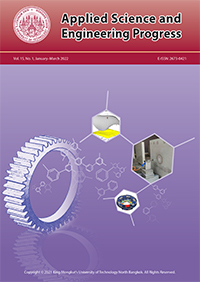Stability Improvement of Brake Disc to Mode Coupling at High Frequency Squeal
Main Article Content
Abstract
In this research study, the high-frequency squeal noise of a brake disc was found to occurred at a frequency of about 15 kHz. The potential root cause has been studied where mode frequency coupling and shape locking mechanism of brake disc and brake pads components are the main investigated topic. From the vehicle field test and the Dynamometer test, the braking condition, friction coefficient and braking pressure, have been confirmed to be used in numerical experiments. The updated finite element model (FEM) with the modal testing data of the existing brake components are formulated for the Complex Eigenvalue Analysis (CEA). In this study, the modification is based on in-board and out-board cheek thickness of the brake disc. Two of nine modifications of the brake disc cheek thickness are proposed with the method of separation the brake disc out-of-plane and in-plane modes and the method of avoiding shape locking between the brake disc and the brake pads modes. The constructed prototypes are verified with the vehicle field test and well agreed with the CEA.
Article Details
References
[2] G. Lou, L. Lee, and B. Malott, “Introduction of anisotropic lining elastic constants optimization (ALCO) method for friction materials,” in the SAE World Congress & Exhibition, 2007, doi: https://doi.org/10.4271/2007-01-0591.
[3] F. Chen, C. A. Tan, and R. L. Quaglia, Disc Brake Squeal: Mechanism, Analysis, Evaluation, Reduction/Prevention. Pennsylvania: Warrendale, 2006.
[4] Disc and Drum Brake Dynamometer Squeal Noise Test Procedure, SAE International Standard J2521_201304, 2013.
[5] Automotive Vehicle Brake Squeal Test Recommend Practice, SAE International Standard J2625_ 200802, 2008.
[6] S. W. Lin, “Squeal suppression approaches of a disc brake assembly,” M.S. thesis, Universiti Teknologi Malaysia, 2009.
[7] J. Park, J. Lee, S. Cho, and K. Yoon, “Reduction of brake squeal analyzed in terms of coupling between in-plane and out-of-plane modes,” in SAE 2012 Brake Colloquium & Exhibition, 2012, doi: 10.4271//2012-01-1828.
[8] T. Yokoyama, T. Matsushima, N. Matsui, and R. Misumi, “A study of reduction for brake squeal in disc in-plane mode,” in Brake Colloquium & Exhibition, 2012, doi: 10.4271/2012-01-1825.
[9] S. Joo, J. Han, J. Kim, and K. Park, “High frequency break squeal prediction index for disc in-plane mode,” in SAE 2009 Noise and Vibration Conference and Exhibition, 2009, doi: https://doi. org/10.4271/2009-01-2102.
[10] F. Chen, D. McKillip, J. Luo, and S. F. Wu, “Measurement and analysis of rotor in-plane mode induced disc brake squeal and beyond,” in 22nd Annual Brake Colloquium & Exhibition, 2004, doi: https://doi.org/10.4271/2004-01-2798.
[11] B. Cha, T. Jung, Y. Hong, S. Park, C. Kim, Y. Hong, and C. Cho, “Design optimization of disc brake for reducing squeal noise by frequency sensitivity analysis,” International Journal of Engineering and Technology, vol. 10, no. 3, pp. 263–268, 2018.
[12] M. Abdel-Naser, I. Ahmed, E. Allam, S. Allam, and S. Abouel-seoud, “Squeal analysis of ventilated disc brake using ANSYS,” International Journal of Energy and Environment, vol. 3, no. 5, pp. 809– 832, 2012.
[13] J. K. Thompson, Brake NVH Testing and Measurements. Warrendale: SAE International, 2011.
[14] MSC Software. “Simulating Brake Squeal Noise,” 2011. [Online]. Available: https://simulatemore. mscsoftware.com/simulating-brake-squeal-noise/
[15] N. Hoffmann, M. Fischer, R. Allgaier, and L. Gaul, “A minimal model for studying properties of the mode-coupling type instability in friction induced oscillations,” Mechanics Research Communications, vol. 29, pp. 197–205, 2002.
[16] M. Nouby, C. Sujatha, and K. Srinivasan, “Modelling of automotive disc brake squeal and its reduction using rotor design modifications,” International Journal Vehicle Noise and Vibration, vol. 7, no. 2, pp. 129–148, 2011.
[17] A. Bajer, V. Belsky, and S. W. Kung, “The influence of friction-induced damping and nonlinear effects on brake squeal analysis,” presented at the 22nd Annual Brake Colloqulum & Exhibition, California, Oct. 10–13, 2004.


